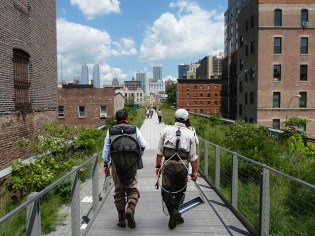
Can a group of fly fishermen and bird watchers find its way in the concrete jungle?
When Bill Ulfelder looks out over the chiseled, concrete and glass landscape of New York City, he sees habitat — not just for people, but for critters, too. Ulfelder is the executive director of the Nature Conservancy in New York (the state, not just the city), and he is on the cutting edge of what could become a major shift for the world’s largest conservation group. The city’s parks and sidewalks, he says, are fertile ground for urban forests. Waterfront parks are prime real estate for marshlands. And all those rooftops? He imagines turning them into a system of “sky island” wildlife preserves.
“There are 22,000 acres of roof space in the city. It’s essentially equivalent to another borough,” he says. “There’s a lot of talk about rooftop gardens and storm-water catchment. But this is also a great opportunity to put habitat back in the city. Don’t just plant sedum [a plant often used in green roofs]. Let’s think about habitat for pollinators and birds.”
It’s the concrete jungle recast as a high-relief Serengeti. Super. Cool.
But what is a treehugger like Ulfelder doing in a town like this? The Nature Conservancy is the ultimate cowboy conservation outfit — and by cowboy, I mean the ones you find in the Sundance catalog. With its national H.Q. in the wealthy enclave of Arlington, Va., just across the river from Washington, D.C., the organization is known for its ability to write huge checks to protect big woods and ranchland. Studiously nonpartisan and science-driven, Conservancy staffers talk about preserving a “portfolio” of “A-grade biodiversity,” while coaxing high-rollers to contribute to the cause.
And contribute they do. In 2010, the Conservancy raked in close to $1 billion. (About a quarter of that was in the form of donated land or revenue from land sales.) That year, the organization bought 2,300 acres of forest surrounding Independence Lake in California, reintroduced bison to one of its preserves in Chihuahua, Mexico, won a 26,000-acre conservation easement in the Everglades, helped lock in protection for 178 million acres of Canada’s boreal forest …
You get the picture. This isn’t exactly the dirtbag-urban-homesteader/community-gardener crowd.
But here’s the rub: The Nature Conservancy’s average member is 62 years old, white, and college-educated, with a $75,000 annual income, Ulfelder says. These demographics are peachy if all you want to do is raise money and buy real estate. Less so if you want your organization to appeal to a broad slice of the public — or to be hip and hopping in another couple of decades, when your current members ride off to that vast Ralph Lauren dude ranch in the sky.
This dilemma isn’t unique to the Conservancy. The conservation movement as a whole has had a bit of a midlife crisis in recent years, crystallized in a much bandied-about 2004 report called “The Death of Environmentalism,” which argued that the movement had lost its mojo. At the Conservancy, Ulfelder remembers a mentor commenting, “We’ll never go away, but we run the risk of becoming quaint — the organization that works in the pretty places far away.”
Last year, in an article in the Conservancy’s in-house publication, Science Chronicles, Carrie Denning, an urban-planning and transportation consultant, and Jon Christensen, director of the Bill Lane Center for the American West at Stanford, argued that if the Conservancy wants to be relevant in a fast-urbanizing world, it should “turn itself inside out,” making “a fundamental shift in how it observes the world — by starting from the viewpoint of the city dweller and looking outwards.”
Their language was even stronger in a follow-up piece published two weeks ago in the Chronicle of Higher Education, co-authored by one of the Conservancy’s senior scientists, Robert McDonald:
The world’s largest conservation organization, the Nature Conservancy, is deep in debate about how to refigure its global strategies in light of these trends [toward urbanization], and its own aging, wealthy, white American base of support. This tweedy fly-fishing and bird-watching demographic bears less and less resemblance to diverse urbanites in the United States, not to mention elsewhere in the world.
“Conservation is facing a crisis of irrelevance — it is an enterprise that is not urgent to most people,” the Conservancy’s chief scientist, Peter Kareiva, recently warned its members. “If conservation is to build the support it needs, it must energize young urban dwellers, who now make up most of the world. The best way to get city people to care about conservation is to do conservation where they live, so that nature is seen as relevant and connected to modern life.”
McDonald points out that the Conservancy is no stranger to cities. It was among the founders of Chicago Wilderness, a network of local groups focused on restoring natural areas. It worked on a major regional planning and habitat protection plan around San Diego, Calif. It has been involved in creating a “water bank” to safeguard the water supply for Santa Fe — an approach the group has used widely in Latin America. And it has recently begun working with local groups in Camden, N.J., to install rain gardens and restore shorelines along the Delaware River.
Still, the recent talk about retooling the organization to focus more on cities is something of a different magnitude. “Traditionally, we have approached what we’ve done as a land trust: You give us your money, and we protect the last and best biodiversity out there,” McDonald says. “There’s more and more focus on how to do projects that are protecting biodiversity that are also good for people.”
It’s too early to tell whether the Conservancy will make a shift as dramatic as the one McDonald and his compatriots propose. So far, reaction from within the organization has been mixed, Ulfelder says. “The New York City folks are totally fired up — they’re saying, ‘What took us so long?’ Then there’s a group out there saying, ‘This is insane. Our resources are too limited.’” The largest group, he says, falls somewhere in between these two extremes, waiting to see whether the organization can find a niche in the urban environment.
And that comes with its own set of challenges. Buddying up with the Ted Turners of the world is one thing. Working in the city, where politics and turf battles flare up block-by-block, and where outside organizations are often viewed with suspicion, can be quite another. (The Conservancy is sometimes accused of not playing well with locals in its international work.) And then there’s the matter of the organization’s pasty complexion.
“We have to come into this with a very large dose of humility,” Ulfelder says. “Our New York City office is the most diverse of any [Conservancy] office in the U.S. But as we work with communities of color, of different economic backgrounds, we will have to be thoughtful. A lot of this is predicated on partnerships [with local groups].”
Ulfelder started by moving the New York office into the city a few years ago. (It had been based in Albany, the state capital.) After six months of research, the organization settled on a short list of areas where it will focus its efforts, including conducting a “biodiversity assessment” of the five boroughs, helping with Mayor Michael Bloomberg’s urban tree initiative, and looking at the potential for creating habitat on rooftops. All of this will be accompanied by a robust public relations campaign, to make sure that New Yorkers understand what the Conservancy is doing, and why.
Ulfelder understands the value of attracting young city-goers to the cause as well as anyone, but he still stays true to the mission: “There are more species in New York City than in Yellowstone,” he says. “New York City has humpback whales and sharks, peregrine falcon, and sturgeon. There’s stuff worth conserving here.”




